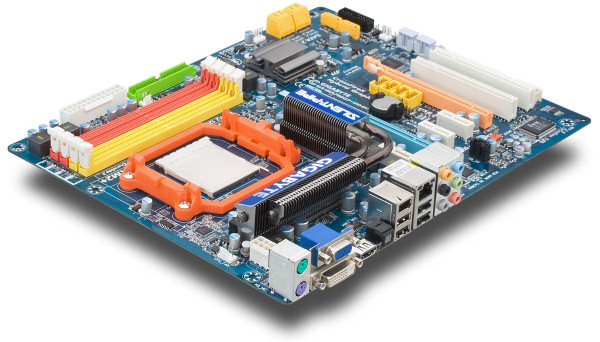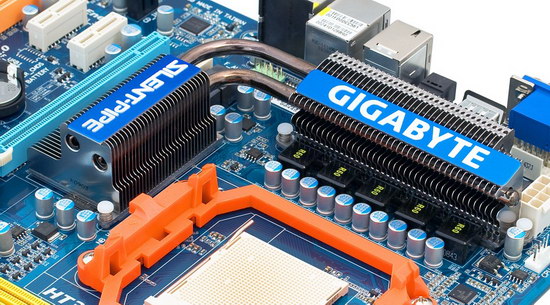All world manufacturers already launched motherboards with AMD 790GX after its rollout. They can boast of the fastest integrated graphics system. In our turn, we published reviews of these motherboards, then we released a roundup. However, with the appearance of Phenom II processors, motherboard manufacturers naturally decided to expand their model ranges with this and other chipsets from AMD in order to attract more consumers. So they want to fight for the expanding market of motherboards for the AMD platform, which is expected to grow with the expansion of Phenom II. On this occasion Gigabyte spared no copper and implemented a very interesting idea, which supplemented the list of Ultra Durable options. This set of options traditionally includes power circuitry features and cooling. Let's see how the overhauled model differs from the previously tested Gigabyte MA790GP-DS4H.
Design


Design of this motherboard resembles the aforementioned MA790GP-DS4H, so they look to be identical at first glance. However, if you take a closer look, you will find some differences. For example, four out of six eSATA ports are L-shaped, so there will be no problems even with a large graphics card installed into the second graphics port. All peripheral connectors without exception have borders, and FireWire ports are also protected with special covers. Formally, they protect the ports from dust and possible instability because of current leakage between contacts. But in practice, if you neglect your computer so much that the motherboard is covered with dust, these port covers will hardly help you. And finally, there is another difference, negative this time -- the board lacks a parallel port, while the older motherboard allowed to install it on a rear panel bracket. If you don't have a printer with this port, you will hardly get one in future, of course. But there are still many owners of such old devices.
Just like the previous model, this motherboard has a 128MB video buffer. Elpida J1116BASE-DJ-E memory chip (DDR3-1333) is partially hidden under the heat sink on the Northbridge, but there is no thermal contact between them, which is not even required: it does not grow very hot, and BIOS does not allow to raise its frequency above the nominal value.
The main cooling system (a couple of heatsinks with heat pipes) got only new labels. But the SB heatsink has been modified, it has probably lower thermal capacity now. However, this chip does not grow very hot. Moreover, its operating temperature is minimized by additional technical solutions that underlie this UD-series of overhauled motherboards. So it would have made sense to save on this heatsink.
It's high time to tell you what innovations let the marketing department increment the index number of Ultra Durable technology to three.

Engineers added twice as thick copper layers for power and ground. It's done for even heat distribution rather than for higher currents (the thicker the conductor, the lower resistance and lower losses to heating) applied to components. Apart from providing electric connections between components, a board is an effective heat sink. Some chips transfer heat through soldered points much better than through their packages, even if they are topped with a heatsink. The thicker layers actually have an interesting effect -- the board itself grows even hotter at the edges. But it apparently happens owing to proportional cooling of the area near the voltage regulator, chipset, and other hot components. It's not easy to determine what this effect gives us in the nominal mode, the system is stable even without such sticks. But when the system is overclocked, this feature should contribute to high results.

The on-board voltage regulator is practically identical to that in the DS4H: five phases, not too many for a modern motherboard of this level. But four Low RDS (on) MOSFETs in each phase (10 transistors marked A2724 U815 and A2726 U821 each) provide the total current, which will be certainly sufficient even for overclocked processors with TDP up to 140 W. The power circuit also contains 10 x 820 uF and 3 x 470 uF solid capacitors from leading Japanese manufacturers.
The bundle is similar to that of the MA790GP-DS4H. Along with the standard set of cables, it includes a bracket with two USB ports. There are no eSATA ports on the rear panel. And you will have to buy a bracket with this port (or an additional controller) on your own. It's not expensive, but it would have been great to get it in the standard bundle.
Write a comment below. No registration needed!




